Military service
As a young man, he joined the life regiment of King Frederick William I. On 4 August 1740 he became second lieutenant and joined the first battalion of the life regiment of the new king Frederick II. There he received the rank of a captain. In 18 June 1745, he became Chief of Staff of the Guard, with the rank of lieutenant colonel. In the First Silesian War, he led his own grenadier battalion composed of companies from Regiments No. 5 Wedel and No. 20 (Voigt). Hagen received command of a grenadier battalion in the Second Silesian War, this time from companies of Regiments No. 13 Truchsess and No. 37 (Moulin). [2]
On 27 October 1745, he took over the company of Lieutenant-Colonel von Wedel, who had fallen in the Battle of Soor. In July 1755 he was promoted to colonel and at the same time became captain of the guard. He was promoted to the major of the guard in August 1756, and became commander of the second and third battalions of the guard. On 3 January 1757 he was appointed major general. After the Battle of Prague in 1757, he commanded Infantry Regiment No. 8. He was badly injured in the debacle at Hochkirch, when Frederick tried to retake the village. He was carried with the army to Bautzen, where he died on 19 February 1759. [2]
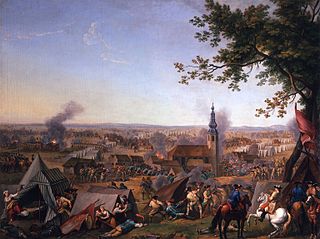
The Battle of Hochkirch took place on 14 October 1758, during the Third Silesian War. After several weeks of maneuvering for position, an Austrian army of 80,000 commanded by Lieutenant Field Marshal Leopold Josef Graf Daun surprised the Prussian army of 30,000–36,000 commanded by Frederick the Great. The Austrian army overwhelmed the Prussians and forced a general retreat. The battle took place in and around the village of Hochkirch, 9 kilometers (6 mi) east of Bautzen, Saxony.

Count Leopold Joseph von Daun, later Prince of Thiano, was an Austrian field marshal of the Imperial Army in the War of the Austrian Succession and Seven Years' War.

The Battle of Soor was a battle between Frederick the Great's Prussian army and an Austro-Saxon army led by Prince Charles Alexander of Lorraine during the Second Silesian War. The battle occurred in the vicinity of Soor, also known as Hajnice, in the modern day Czech Republic. The battle started with a failed Austrian surprise attack on the outnumbered Prussians. Despite initial setbacks the Prussian army managed to defeat the Austrians, due to an unexpected attack from a reserve regiment that refused to follow Frederick's orders.

Ferdinand, Prince of Brunswick-Lüneburg, was a German-Prussian field marshal (1758–1766) known for his participation in the Seven Years' War. From 1757 to 1762 he led an Anglo-German army in Western Germany which successfully repelled French attempts to occupy Hanover.
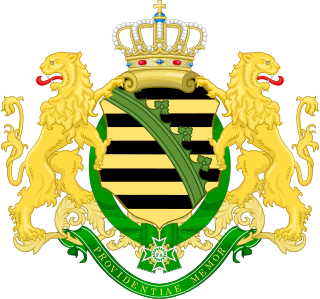
The Royal Saxon Army was the military force of the Electorate (1682–1807) and later the Kingdom of Saxony (1807–1918). A regular Saxon army was first established in 1682 and it continued to exist until the abolition of the German monarchies in 1918. With the formation of the Confederation of the Rhine by Napoleon the Royal Saxon Army joined the French "Grande Armée" along with 37 other German states.
The Royal Bavarian Infantry Lifeguards Regiment was a household-lifeguard (bodyguard) regiment of the Bavarian kings from the end of the Napoleonic Wars until the fall of the Wittelsbach monarchy and the subsequent disbanding of the Bavarian army.

Carl Heinrich von Wedel was a Prussian lieutenant general in the War of Austrian Succession (1740–1748), the Seven Years' War (1756–1763), and the War of Bavarian Succession (1778–1779). He fought most notably in the Battle of Tornow in 1758, and the Battle of Kay in 1759. He was instrumental in Frederick the Great's victory at Leuthen in December 1757.

Christoph II, Burggraf and Count of Dohna-Schlodien was a Prussian general. He was the son of Christopher I, Burgrave and Count of Dohna-Schlodien (1665–1733). He served in the armies of Frederick William I of Prussia and his son, Frederick II, in the Silesian and Seven Years' wars. He was particularly successful at the Battle of Gross-Jägersdorf, and instrumental in relieving Siege of Kolberg.
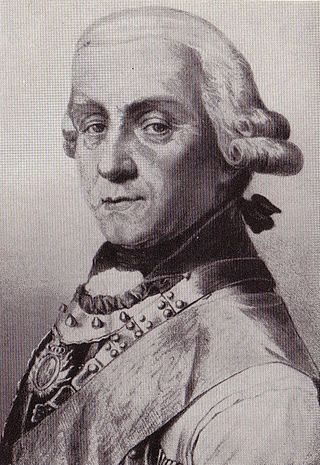
Joachim Bernhardt von Prittwitz and Gaffron (1726–1793) was a Prussian officer credited with saving the life of Frederick the Great at the Battle of Kunersdorf. At the time, he was a cavalry captain in Hans Joachim von Zieten's Hussar regiment. He became the head of gendarmes regiment, and inspector general of the cavalry of Brandenburg March and Magdeburg in 1775. He was promoted to lieutenant general in 1785 and general of cavalry in 1788. Frederick awarded him the Order Pour le Mérite and the Order of the Black Eagle. In 1851, Prittwitz was included on the panels of the Equestrian statue of Frederick the Great as one of the key figures in the establishment of the Prussia state.

Karl Wilhelm von Dieskau was a Prussian lieutenant general and general inspector of the artillery. He participated in twelve campaigns, ten battles, nine sieges. He received the Black Eagle Order, the Order Pour le Mérite, and was included in 1851 on the Equestrian statue of Frederick the Great. He is general credited with creating Frederick the Great's vaunted horse artillery.
Hans Caspar von Krockow was a Prussian major general and commander of the Cuirassier Regiment No. 1. He was the Amtshauptmann of the Giebichenstein and Moritzburg estates as well as heir to Estate A at Peest (Pieszcz), Paalow (Pałowo), Franken, Thien (Tyń) and Nitzlin (Nosalin). He fought in the Seven Years' War and died of injuries received at the Battle of Hochkirch.
Karl Christoph Freiherr von der Goltz was a lieutenant general in the Prussian army during the reign of Frederick the Great.

Siegmund Moritz William von Langen, also called Simon Moritz,, was a Prussian major of the who died of injuries received in the Hochkirch churchyard during the Battle of Hochkirch, in the Seven Years' War. His actions at Hochkirch delayed the Austrian forces sufficiently for Frederick the Great to organize a retreat. This saved the Prussian army.
Kaspar Ernst von Schultze was a Lieutenant General of infantry in the Prussian Army, commander of the Breslau fortress, and director of the royal riding academy in Liegnitz. He was also the heir of the family estates at Mahlen in the Silesian county of Trebnitz. He fought in the wars of Spanish and Austrian succession, the Great Northern War, and the Seven Years' War. He served in the Prussian army under three monarchs: Frederick I, Frederick William I, and Frederick II. His name was included in 1851 on the Equestrian statue of Frederick the Great honoring the men considered to be the founders of the modern Prussian state.
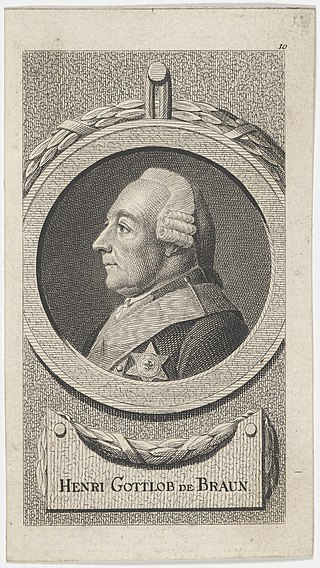
Heinrich Gottlob von Braun was a Prussian general of infantry. He served Frederick the Great during the War of Austrian Succession, and received the Order Pour le Mérite and the Black Eagle Order. In 1851, he was also memorialized on the Equestrian statue of Frederick the Great.

Peter Ludwig du Moulin was a Prussian General of Infantry and served Frederick the Great during the War of Austrian Succession (1740–1748). He served three Prussian kings, including Frederick, Frederick William I, and Frederick I, and fought in the major Prussian wars of the first half of the eighteenth century. During 1730–1731, he was quartermaster of the Prussian field armies. From 1741 to 1755, he was proprietor of the Infantry Regiment Nr. 37.

Peter Ernst von Pennavaire was the son of a French advocate (attorney) in Toulouse who fled France in about 1685. He served in the Prussian army, achieving the rank of lieutenant general of cavalry and proprietor of the Leib-Carabiniers. He was the recipient of the Black Eagle Order and Pour le Mérite. At age 80, he led his cavalry in a charge at the Battle of Breslau at the Austrian front, and died of complications from injuries he received there.
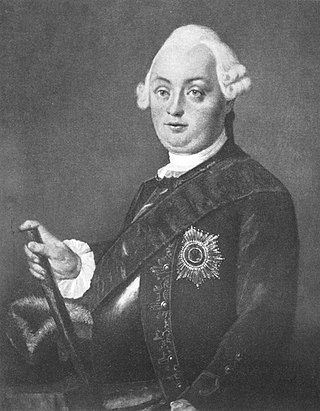
Joachim Friedrich von Stutterheim („Alt-Stutterheim“),. He was known as the Old Stutterheim to distinguish him from his younger brother, Otto Ludwig (1718–1780), also a lieutenant general in Frederick the Great's army.
Josip Šišković was a Habsburg senior military officer and official of Croatian origin, a member of the Šišković noble family residing in Bačka. He held the rank of artillery general of the imperial army of the Habsburg monarchy and the title of count. In over forty years of his career, he participated in the many battles and wars waged by the Monarchy during the 18th century. In them he distinguished himself with exceptional knowledge, ability and courage, so he received a number of decorations for his merits, including the Knight's Cross of the Military Order of Maria Theresa (1758) and the Commander's Cross of the same Order (1765). He also received political and government appointments.
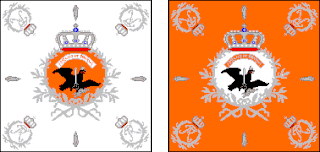
The 1st Prussian Infantry Regiment was a line infantry regiment of the Old Prussian Army which had initially formed part of the Prussian Life Guard, but later transferred to the line. After notably serving in the War of the Austrian Succession and Seven Years' War, the regiment was demolished following the Battle of Auerstadt. A small part of the regiment went on to help form the famed 8th Life Infantry Regiment, which in turn would serve notably till its disbandment after World War I.














